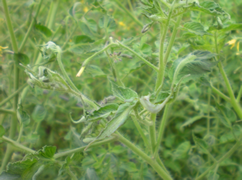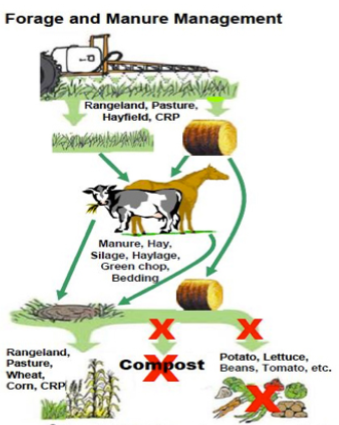Taking an environmentally sensitive approach to pest management
Herbicide Contamination and ‘Outgassing’ in High Tunnels or Greenhouses
Published: August 1, 2015
We have previously written about the risk of herbicide contamination from products like Grazon. If you are unfamiliar with this issue, please see the insert which was distributed pre- viously. This article will focus on a phenomena associated with the ac- tive ingredients in this chemical class (the pyridine carboxylic acids), de- scribed as ‘outgassing’.
This summer we had 3 heated high tunnels with tomatoes planted in the soil, that all experienced a similar problem. The tomato plants displayed symptoms (see photo to right) consistent with exposure to growth regulator type herbicides (which also includes 2,4-D), but it occurred AFTER the plants had been growing well for anywhere between a few weeks to well over one month. And the symptoms were variable in severity, typically from none to moderate. The farms where this happened were at 3 different communities (Clark, Prairie Home, and Windsor) and none had used any common inputs. Furthering the mystery was that high tunnels in the vicinity which had used common inputs (such as compost) had no problems. We ran through all the possibilities of herbicide contamination, such as drift from roadside or pasture spraying (looking for afflicted broadleaf plants out side the high tunnel can help rule this out. Just to reiterate the various possible sources, here’s a list.

Home garden tomato about one week after mulching with contaminated old hay. Photo by Dean Volenberg
- Spray drift as just discussed.
- Sprayer used on the crop had previously contained herbicide and wasn’t cleaned well.
- From hay, manure or compost as discussed in this insert.
- From soil brought in where herbicides with long carryover had been applied.
- From pond water where herbicide runoff has occurred. Brushkiller has been a culprit for this.
All we could find in common was use of hay or straw as mulch.
Two questions still remained:
- One location used straw, which we thought was ‘safe’, as it is not mentioned as a risk, e.g. in the publication insert.
- Why the delayed response? The tomato crops grew well for some time. And in none of the 3 locations, did the symptoms occur just after the hay or straw was put between the beds.
Regarding straw, there are several herbicides registered on wheat that contain this chemical class. Curtail is a fairly common herbicide containing clopyralid and while the product is mentioned in the publication insert, wheat straw is not mentioned. This chemical class is quite effective on marestail, which row crop farmers jump at the chance to control, since marestail is difficult to control with glyphosate or Roundup. Furthermore, the label for Curtail does NOT warn sufficiently about the potential of harm.
On the second question, why a delayed response? Active ingredients from this chemical class can release into the atmosphere, which a MU Weed Scientist termed ‘outgassing’. This is more likely to occur when it warms up or gets hot. So if it is cool or cloudy after contaminated old hay, straw or compost is applied, no initial effect is seen.

©Copyright 2011 Dow AgroSciences LLC
Furthering the oddity is these chemicals are effective in extremely tiny amounts, and when in a closed environment, will be even more potent. And which plants may be more affected might depend on a number of factors such as proximity to contaminated hay and air currents in the tunnel. In 2 of the 3 locations the problem was not substantially dam- aging. The plants in Clark were first damaged in April, recovered fairly quickly, and by June no damaged foliage was noticeable.
This year we have had numerous reports of contamination in Missouri from compost and old hay. And colleagues in other states have reported these problems seem to be on the rise. The chemical companies are trying to make it clear about the dangers associated with these products (see diagram below), but there is a real disconnect when a farmer doesn’t read a label or may hire out his spraying. Consumers have been encouraged to ‘know your farmer’. Now we can say horticulture producers need to know their manure, hay, straw, and compost.
Note: Poultry litter and its compost should not have this same risk.
Subscribe to receive similar articles sent directly to your inbox!
REVISED: November 16, 2015